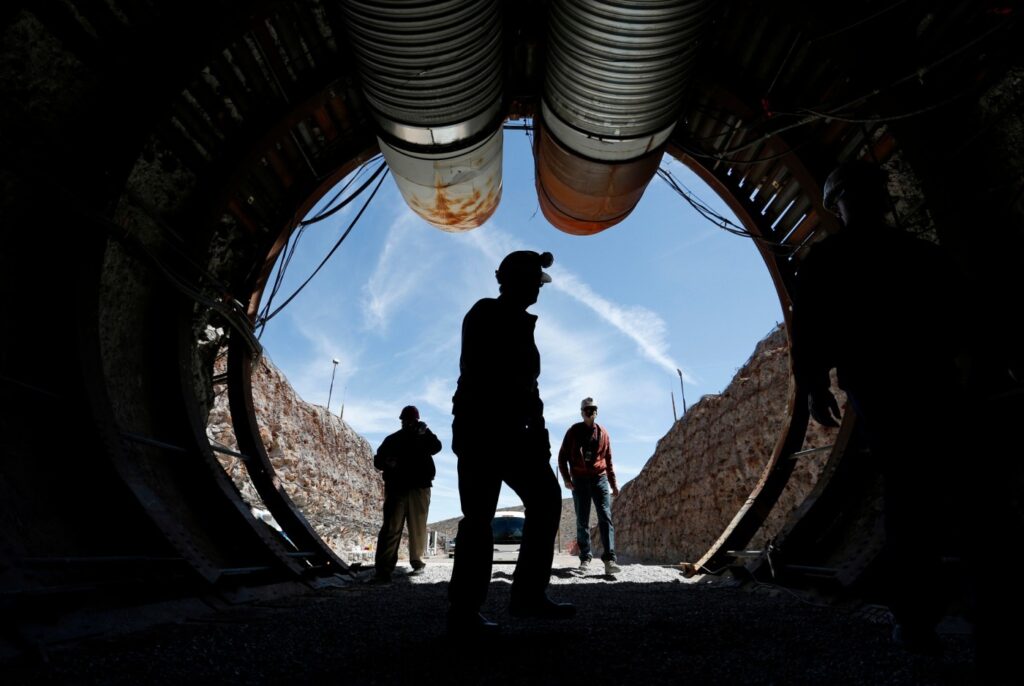
Dry storage of used fuel rods at the San Onofre Nuclear Generating Station in Camp Pendleton, CA, on Thursday, December 16, 2021. (Photo by Jeff Gritchen, Orange County Register/SCNG)
One of the quickest ways to get nuclear waste off San Onofre’s bluffs, relatively speaking: temporary storage sites, run by private companies, that aren’t surrounded by 8 million people.
There was optimism on Southern California’s quake-prone coast when, in September, the Nuclear Regulatory Commission issued a license for exactly that for a facility in Andrews, Texas. It didn’t take long for Texas’ governor to sign a bill denying state construction permits for such a project — and now, Congressmembers seek to put a financial nail in the coffin.
Senators Martin Heinrich, D-New Mexico, and Ted Cruz, R-Texas, introduced legislation to forbid federal funds from being used to pay for private interim storage on Wednesday, March 2. In the House, a companion bill was being introduced by Reps. Teresa Leger Fernández of New Mexico, a Democrat, and August Pfluger of Texas, a Republican.
That would render any private facility impractical. More than $40 billion languishes in the federal government’s Nuclear Waste Fund — money paid by consumers, so the federal government could dispose of the stuff — and that money would need to be tapped to pay for temporary storage.
“This is straight-up self-interest of New Mexico and Texas,” said David Victor, professor at UC San Diego’s School of Global Policy and Strategy and chair of the San Onofre Community Engagement Panel, a volunteer group that advises Southern California Edison on San Onofre’s decommissioning, by email.
“I suspect it has zero chance of being adopted — it is a signal to voters in those states that their senators are ‘doing something.’”
Lawmakers in Texas and New Mexico fear temporary storage sites wouldn’t be temporary at all. “Texas will not become America’s nuclear waste dumping ground,” Gov. Greg Abbott has said.
U.S. Rep. Mike Levin, D-San Juan Capistrano, has prioritized consent-based storage and helped secure federal funding to restart the U.S. Department of Energy’s separate effort to find temporary, public storage sites.
“I respect the right of New Mexico and Texas to oppose storage in their states, but limiting any opportunity for other communities to engage in a consent-based process for interim storage is counterproductive and wrong,” Levin said by email.
Levin said that “anyone concerned about nuclear waste at San Onofre or anywhere else should support that process.”
If the looming conflict sounds familiar, that’s because it is. The federal government spent more than $10 billion on what was to be America’s permanent disposal site at Yucca Mountain, even as Nevada state officials vehemently opposed it.
Projects
The NRC licensed Interim Storage Partners, a joint venture of Waste Control Specialists and Orano USA, to build and operate the “consolidated interim storage facility” in Texas on Sept. 13.
It would be built beside low-level storage that already exists there, and house millions of pounds of high-level waste currently languishing at commercial sites like the shuttered San Onofre plant. It’s licensed for up to 40 years, and would close when the federal government finally builds a permanent disposal site.
Holtec International has applied for a license for a similar temporary facility in Lea County, New Mexico.
But being licensed clearly doesn’t mean private projects get built, even without federal legislation getting in the way. The NRC issued a license for temporary storage to a company called Private Fuel Storage in 2006, but the project never came to fruition.
The vexing problem of what to do with the 190 million pounds of highly radioactive waste piling up at commercial nuclear reactors all over the nation grows more acute each day. And it’s expensive.
The federal government was supposed to start collecting commercial waste in 1998, but hasn’t accepted an ounce for permanent disposal. That hits taxpayers in the pocketbook: Because plant operators have had to build secure storage on site while they wait for the feds to craft a solution, they’ve sued the Department of Energy and won $9 billion in settlements and judgments.
The Government Accountability Office says it may cost another $30 billion before there’s a solution. Industry experts peg the bill as high as $50 billion.
On a separate, public track, the U.S. Department of Energy is trying to restart an Obama-era push for federal “consent-based siting.” It’s collecting thoughts on how to do that fairly and equitably at consentbasedsiting@hq.doe.gov. Responses must be received by 2 p.m. PST on Friday, March 4.
Nuclear energy is “absolutely critical” to addressing climate change, but the nation can no longer ignore the conundrum at the back end of the fuel cycle – how to dispose of the waste – said Kathryn Huff, principal deputy assistant secretary for nuclear energy with the DOE, when the push was announced in November.
“Management of the fuel is the responsibility of the DOE,” Huff said. “We cannot continue to defer this challenge for future generations to figure out. … Communities did not agree to host this waste in the very long term.”
Southern California Edison, San Onofre’s operator, said it remains focused on the DOE’s efforts to create a federal temporary site, as well as a permanent federal disposal facility.
The Associated Press contributed to this report.
